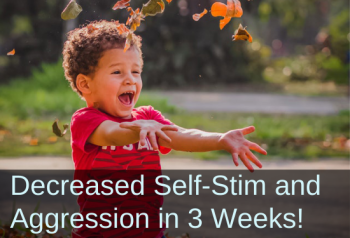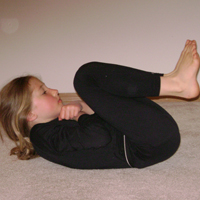From Aggressive to Giggly and Playful -- Rhythmic Movements and Reflex Integration Make a Big Difference for 5YO Boy
Submitted by A.T., OTR/L

|
Before
|
After
|
|
High frequency of self-stimulatory behaviors such as flapping, full body flexion, and jumping/heel raises
|
Decreased self-stimulatory behaviors
|
|
Frequent agressive behavior
|
Decreased aggressive behavior; and generally more smiley, giggly, cuddly, and playful
|
|
Unable to communicate
|
Improved efforts to communicate, icluding eye contact, gestural communication, and first imitation of a wave paired with a ‘B’ sound
|
|
Messy
|
Keeping his room more organized
|
|
Clumsy
|
Less clumsy
|
GN is a sweet 5 y/o male with ASD, non-verbal, frequent self-harm and aggressive behaviors. He has been receiving occupational therapy 5x/week since age 2 in addition to ABA therapy and SLP 5x/week+. Rhythmic movement and reflex integration as described in this [Brain and Sensory Foundations] course were provided consistently for 3 weeks. Attempts to engage parents and nannies were unsuccessful, however, he continued to receive these movements on a daily basis during OT sessions and ABA sessions.
GN demonstrates mixed sensory processing including high seeking of proprioceptive and tactile through the hands as well as inconsistent tactile sensitivity to the head, neck, and back. He is sensitive to auditory inputs while also seeking -- constantly making odd sounds and often seeking sounds in his familiar environments. He is high oral seeking and a very picky eater. He is almost constantly seeking proprioceptive input and is regulated by rhythmic vestibular input. High frequency of self-stimulatory behaviors such as flapping, full body flexion, jumping/heel raises, oral seeking, gathering, and picking. GN has global delays in both gross motor and fine motor skills. He has difficulty with following 1-step directives and benefits from predictable routines and visual cues. GN was born via cesarean and had a hospital stay of 3 days post-partum.
When engaging in reflex checks, GN demonstrated strong responses related to unintegrated reflexes in almost all of the reflexes. Due to the nature of GN’s delays and difficulty with following directives, rhythmic movements [from the Brain and Sensory Foundations course] were started during OT sessions.
GN was receptive to the rhythmic movements and tolerated them well during session. His ABA therapist reported that he highly enjoyed and by the second week was requesting the movements during all of his ‘breaks’ during the day. Fortunately another OT at the clinic was participating in this course at the same time as I was, and therefore we were able to support each other when implementing passive reflex integration. [from the Brain and Sensory Foundations course]. It is worth noting that GN’s tolerance for passive reflex integration fluctuated and at times he would have to engage in familiar rhythmic motions and sensory activities in order to be able to get to a state in which he would tolerate the activities
GN worked on integrating TLR as a foundational reflex as it was still very active when checked and supports his head/neck movements and strength, as well as balance, alignment, posture, and also due to ease of engaging him in the integration activities. GN was receptive to rocking and spinning, rhythmic movement 1, and isometrics. He naturally responded to light pressure on his body throughout the reflex integrations. GN did not enjoy doing activities in prone or on his belly and they had to be worked up to and done in very short increments. GN worked on hand reflexes through putty and dough play as well as maintaining crawling positions, rocking in quad, and joint compression. Again, fatigue and maintaining interest were key and activities were constantly being modified for best fit and engagement.
Following 1 week of regular rhythmic movements [from the Brain and Sensory Foundations], GN’s team all noticed improved behavior, including decreased self-stimulatory behaviors, decreased aggressive behaviors, and a generally more smiley, giggly, cuddly, and playful young boy. His inappropriate seeking behaviors had decreased and his eye contact and attempts to communicate were increasing including PECS exchanges as well as gestural communication. Most excitingly, GN demonstrated his first imitation of a wave with fingers outstretched (instead of curled with minimal movements) paired with a ‘B’ sound following my saying ‘Bye-bye’ with a wave. The hope is that GN will continue to upon this trajectory by continuing to engage in consistent rhythmic movement input and participation in reflex integrating activities. It was amazing to see what consistent rhythmic input can do for a client. Moving slowly and not pressuring clients before they are ready can have major benefits during these reflex movements.
(Edited, emphasis added)


